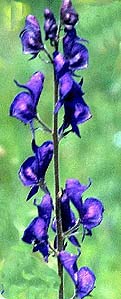Common monkshood, Friar'scap
| Syn.: Garden wolfsbane Aconitum napellus The genus name Aconitum comes from the Greek term en akonias, which means âgrowing on bare rocksâ. |
The common monkshood is a high plant with slim stem and beautiful blue blossoms. It is native to mountain slopes in Europe and east to the Himalayas. It grows on wet grassland, stony or rocky slopes, and near forest streams of altitude that is larger than 1200 m. During the blooming season, the plant is very prominent against the background of other plants and attracts the eye.Wolfsbane is a perennial herb of the buttercup family Ranunculaceae. The plant is successfully cultivated, often as a decorative element in parks and home yards.
The common monkshood is one of the most poisonous plants of European flora. Since ancient times, people have known that it is poisonous and have used it as a weapon by coating their spears and arrowheads with its strong poison. The plant was used for killing panthers, wolves and other carnivores. The ancient Roman naturalist Plinius describes friarâs cap under the name âplant arsenicâ. It was often used for criminal purposes.
Aconitum napellus Alkaloids contained in the plant are responsible for its poisonous effect. Their highest concentration, from 0.2 to 3%, is in young tubers.The main alkaloid is aconitine. During blooming the roots contain a minor amount of aconitine but it grows larger and reaches its maximum in the winter. That is why only young tubers gathered in the autumn are used as a drug. Since tubers easily disintegrate, they should be stored in a dark place.
Aconitine is one of the strongest plant poisons. At first, it acts as a stimulant but, after that, it paralyzes the nervous system. Doses of 2-5 mg can kill an adult. The symptoms of poisoning are oral paresthesias, abundant salivation, nausea, vomiting and diarrhea. The skin becomes cool, the limbs become insensitive and the pulse accelerates. Death results from respiratory failure and cardiac arrest. Children may get poisoned if they hold tubers in their hands for a long time.
If it is carefully dosed, aconitine is applied externally as a painkiller in neuralgia in cases of rheumatism, headache, gout, migraine and colds accompanied with high body temperature. Several medicines are produced from tubers of low content of alkaloids. Due to its strong toxicity, the drug is very rarely used internally.
In homeopathy, Aconitum napellus is considered one of the most important medicinal plants. In Tibetan medicine, aconitine is the most valuable drug and is referred to as âthe king of medicinesâ. Its alkaloids are also used in agriculture for killing harmful rodents and insects.

